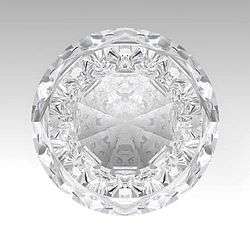Mental Ray
| Original author(s) | Mental Images |
|---|---|
| Developer(s) | Nvidia |
| Initial release | 1989 |
| Stable release |
3.14
|
| Preview release |
3.14
|
| Operating system | Linux, OS X, Microsoft Windows[1] |
| Type | Renderer |
| License | Proprietary software |
| Website |
www |
Mental Ray (stylized as mental ray) is a production-quality rendering application developed by Mental Images (Berlin, Germany). Mental Images was bought in December 2007 by NVIDIA. As the name implies, it supports ray tracing to generate images.
Mental Ray has been used in many feature films, including Hulk, The Matrix Reloaded & Revolutions, Star Wars: Episode II – Attack of the Clones, The Day After Tomorrow and Poseidon.[2][3]
Features

The primary feature of Mental Ray is the achievement of high performance through parallelism on both multiprocessor machines and across render farms. The software uses acceleration techniques such as scanline for primary visible surface determination and binary space partitioning for secondary rays. It also supports caustics and physically correct simulation of global illumination employing photon maps. Any combination of diffuse, glossy (soft or scattered), and specular reflection and transmission can be simulated.
Mental Ray was designed to be integrated into a third-party application using an API or be used as a standalone program using the .mi scene file format for batch-mode rendering. Currently there are many programs integrating it such as Autodesk Maya, 3D Studio Max, AutoCAD, Cinema 4D and Revit, Softimage|XSI, Side Effects Software's Houdini, SolidWorks and Dassault Systèmes' CATIA. Most of these software front-ends provide their own library of custom shaders (described below). However assuming these shaders are available to mental ray, any mi file can be rendered, regardless of the software that generated it.
Mental Ray is fully programmable and infinitely variable, supporting linked subroutines also called shaders written in C or C++. This feature can be used to create geometric elements at runtime of the renderer, procedural textures, bump and displacement maps, atmosphere and volume effects, environments, camera lenses, and light sources.

Supported geometric primitives include polygons, subdivision surfaces, and trimmed free-form surfaces such as NURBS, Bézier, and Taylor monomial.
Phenomena consist of one or more shader trees (DAG). A phenomenon looks like regular shader to the user, and in fact may be a regular shader, but generally it will contain a link to a shader DAG, which may include the introduction or modification of geometry, introduction of lenses, environments, and compile options. The idea of a Phenomenon is to package elements and hide complexity.
Since 2010 Mental Ray also includes the iray rendering engine, which added GPU acceleration to the product. In 2013, the ambient occlusion pass was also accelerated by CUDA, and since 2015 the GI Next engine can be used to compute all indirect/global illumination on GPUs.
In 2003, Mental Images was awarded an Academy Award for their contributions to the mental ray rendering software for motion pictures.
See also
- PhotoWorks (ray tracing software), part of SolidWorks which uses a version of the Mental Ray rendering engine as its renderer.
Notes
- ↑ http://www.nvidia-arc.com/products/nvidia-mental-ray/availability.html
- ↑ "mental images Software Developers Receive Academy Award". Mental Images Press Release, April 23, 2011
- ↑ "Large as Life: Industrial Light & Magic Looks to mental ray to Create "Poseidon"". Mental Images Press Release, April 23, 2011
Further reading
- Driemeyer, Thomas: Rendering with mental ray, SpringerWienNewYork, ISBN 3-211-22875-6
- Driemeyer, Thomas: Programming mental ray, SpringerWienNewYork, ISBN 3-211-24484-0
- Kopra, Andy: Writing mental ray Shaders: A perceptual introduction, SpringerWienNewYork, ISBN 978-3-211-48964-2
External links
| Wikimedia Commons has media related to With mental ray generated images. |
- Mental Ray home page
- Mental Ray user wiki
- Mental Ray user blog
- mental ray and iray for CINEMA 4D by at² GmbH
- MetaSL Material Library